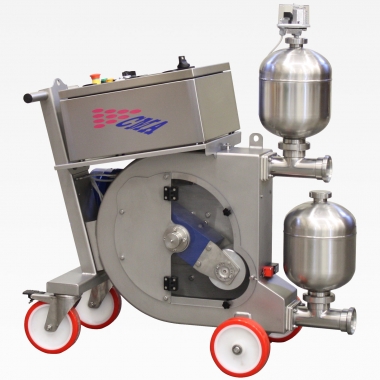 |
       
 Peristaltic pumps PULSAR 150 Peristaltic pumps PULSAR 150
 C.M.A. widens her own production introducing some new models of pumps: the peristaltic pumps PULSAR. These pumps give to the customers a delicate method for transferring of grapes, destemmed grapes, must, marc, and others liquids, mixed with solid parts, for the alimentary industry. The transferring of the product is obtained by the action of two rollers on a rubber tube. The rotation of the rollers creates inside the tube an alternative movement of chambers, with inside the product, this continuous movement of opening and closing generates a linear flow.
The product is treated with utmost delicacy, without crushing, emulsion or shakings.
The peristaltic pump's laudable characteristic is to have no moving parts in contact with the product moved, limiting to the maximum the wear of all mechanical parts.
It can also work dry without damages or problems.
PULSAR pumps are provided in the standard version with various accessories:
• Pump body made entirely of stainless steel aisi 304 with very thick metal sheets.
• Frame on four wheels: two of them are spinning wheels with brakes.
• Pipe fitting complete of expansion chamber (Ø250 mm) for suction/outlet connections and safety pressure switch.
• Single pipe and two roller-rotor supported both on the motor side and on the opposite side.
• Pressing rollers mounted on eccentric axles in order to settle the pressure in the tube.
The rollers can be dismantled by removing only two screws.
It is advisable to remove one of the two rollers when the pump stops for a long period, to not have the tube in compression.
• Three lubrification points for the tube, easily accessible from outside of the pump.
• Polycarbonate protection opened by removing only two knobs.
• Plastic control panel with electronic speed variator (inverter).  Optionals Optionals
 • Control panel made of stainless steel.
• Receiving hopper with motorized auger for pump feeding, complete of speed variator. The ending part of the auger is conical and seated in a proper reduction until the diameter of the output tube in order to prevent the crush of the product.
|
 |
 |
 |





